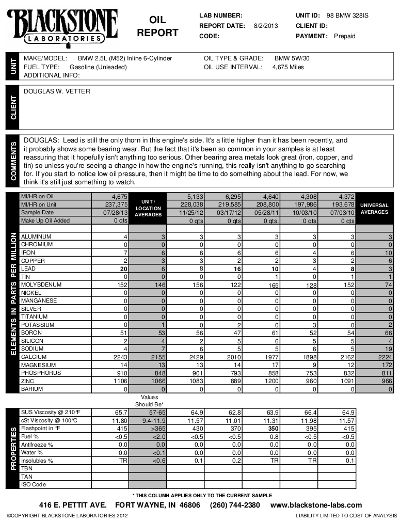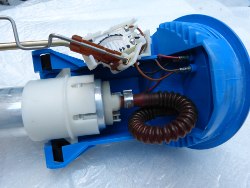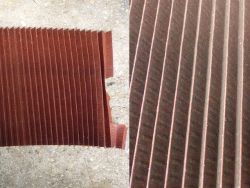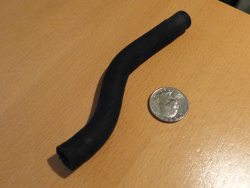Friday, July 26, 2013
While I was updating my maintenance schedule worksheet I realized that I was due a bunch of work. I had some time off so I decided to tackle it.
Fuel Pump
Failure of a fuel pump can be costly as well as inconvenient, particularly if it occurs at the wrong place and time. I've heard rumblings over the last several years that pumps seem to be failing more often due to what some attribute is the contamination of our gas with Ethanol so I felt comfortable justifying the replacement of the otherwise functional pump in accordance with my preventative maintenance schedule. I wound up replacing it a few thousand miles later than my usual replacement interval of 108K but now that it's done I shouldn't have to worry about getting stuck on the side of the road for several years, and hopefully by that time I'll no longer rely on the car as a daily driver.
Given my familiarity with the process it took me less than an hour to replace the pump. The only snag occurred when I tried to remove one of the electrical connectors. The connector bodies are made of plastic and because the tank is on the exterior of the vehicle the shells are exposed to the weather. They tend to get brittle over time and these had seen better days. As I pressed both retaining clips to remove the connector one side just broke off. A quick call to the dealer revealed (surprise, surprise) that they didn't have the shells in stock but could order them. Fortunately the connectors fit snugly with the pump despite the broken retaining clip so I buttoned everything back up for now and will plan to replace the connectors later.
Oil Service
The oil service was routine except for the fact that I took an oil sample. I'm not expecting anything other than slightly elevated lead but if I start to see other metals rising too that means the bearings have worn sufficiently to require a teardown. With over 237K on the clock, anything is possible.
[Edit: 8/2/2013]: The sample came back today and lead is higher than expected at 20 PPM. The count is particularly troubling because it's the highest I've seen in the last couple of years and nearly twice the particle count when normalized for mileage (0.0042 PPM per mile) as compared to the 3/17/2012 sample of 16 PPM which was taken over roughly 6300 miles (0.0025 PPM per mile). As the analyst noted this is something to watch but for now the metals beneath the lead are not showing up in the samples. Of course, that only means that the bearings haven't worn through the relatively thick lead layer, but when they do I am concerned the other metal counts will skyrocket -- perhaps faster than I can detect between samples -- and damage to the mating parts will be swift. Sudden stoppage would not be out of the question.
 The analyst is correct that I should be watching for abnormal oil pressure
but I can't very well do that because the idiotic engineers at BMW never saw
fit to equip a sports car with proper engine gauges. Unfortunately, by the
time the oil pressure idiot light illuminates, at least in this context, I
might as well chuck the engine. So, what can I do? I don't think this warrants
pulling the engine prophylactically, of course, but I have decided to go back
to sampling at every oil service to improve the data set and better analyze
the trend. [End Edit]
The analyst is correct that I should be watching for abnormal oil pressure
but I can't very well do that because the idiotic engineers at BMW never saw
fit to equip a sports car with proper engine gauges. Unfortunately, by the
time the oil pressure idiot light illuminates, at least in this context, I
might as well chuck the engine. So, what can I do? I don't think this warrants
pulling the engine prophylactically, of course, but I have decided to go back
to sampling at every oil service to improve the data set and better analyze
the trend. [End Edit]
Fuel Filter
While replacing the fuel filter I decided to replace the short pieces of fuel hose connecting the filter to the hardline that goes to the tank (what I choose to call the upstream hose) and the regulator (downstream hose). The good news is that even after 15 years the fuel hose is flexible and seals well so I don't see an immediate need to replace all the hose on the car, but Mike Miller of the BMWCCA recommends all fuel hose be replaced every 150K miles or 10 years, and I've exceeded both limits so I'll probably make plans to do it anyway. After all, I'd hate to lose the car to a fuel-related fire.
BMWs fuel filter replacement kit includes a couple of small hose clamps and the pre-cut "upstream" segment. When I ordered what I thought was the downstream segment I was sent a 3 foot long piece of fuel hose that cost a pretty penny (BMW really loves its fuel hose...let me tell you). Today when I pulled the downstream segment I noticed that the hose was printed with a distinct part number (last seven digits: 1744068) and was molded with an offset to prevent the hose from rubbing on the body of the regulator. Instead of put everything back together with the existing hose I matched the length and cut a section of straight fuel hose slightly oversize to accommodate the offset. It has at least 5mm of clearance to the regulator body and is not kinked. I'll inspect it again in a few months to ensure it's not rubbing.
As is customary in the aviation industry where regulations require technicians to cut filters open and inspect the media to determine the type and extent of contamination, I cut both ends off the fuel filter and pulled the element to inspect it. The good news is that the heavy paper filter media was still in great shape even after nearly 75K miles in service and the interior of the filter media (the downstream side) was perfectly clean, meaning nothing was passed to the engine. The upstream side was perceptably dirty, however, and the surprise was the slight greenish tint of the dirt. I'm not sure what it is, but the message received was that 70K is probably an acceptable replacement interval. For this reason I've changed my maintenance schedule to increase the filter change interval from 54K to 70K miles.
Mileage: 237375






